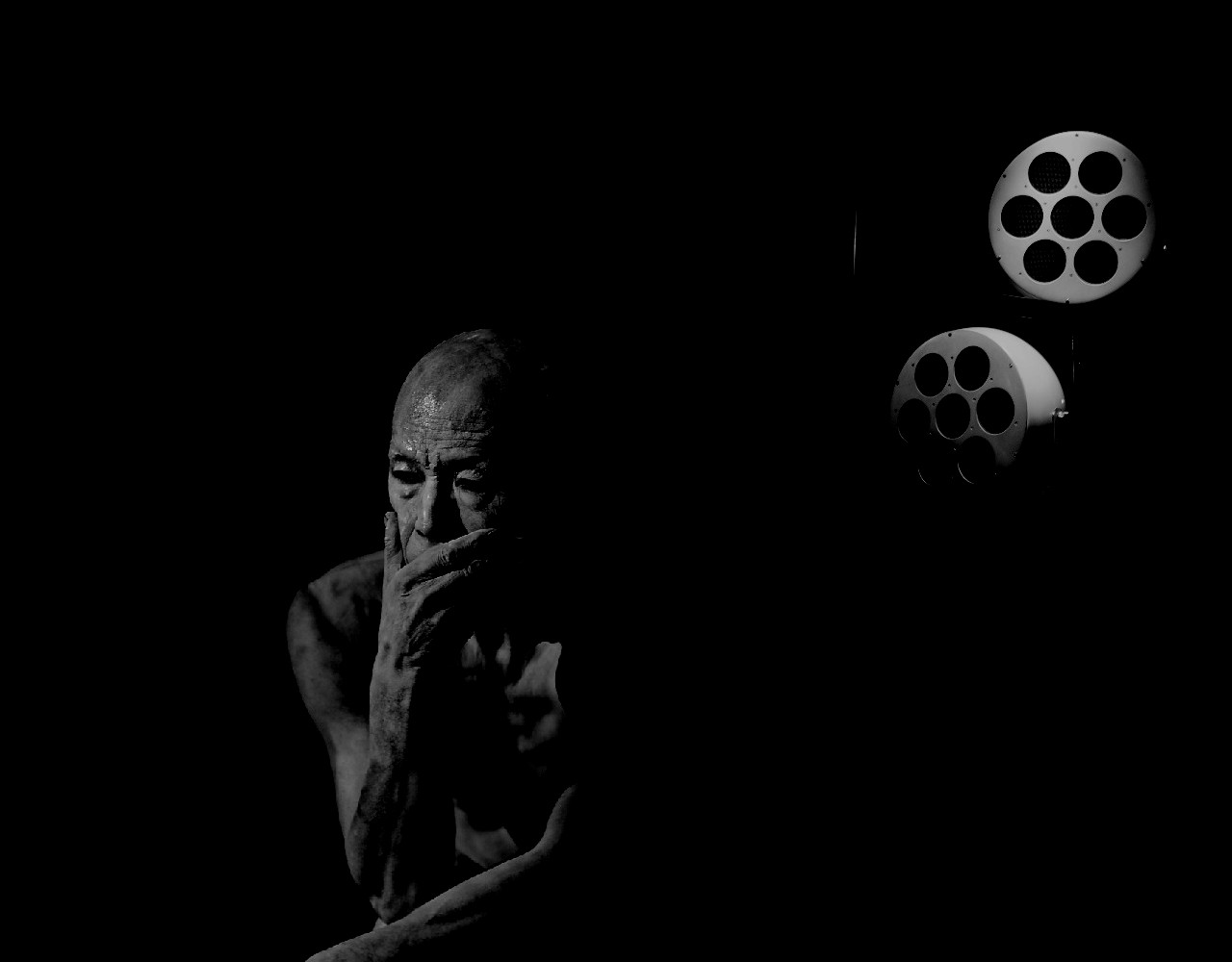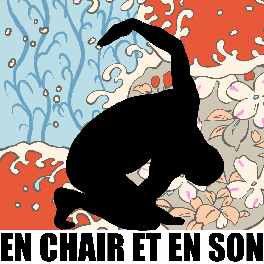
EN CHAIR ET EN SON
Home > Butoh and acousmatic
THE MEETINGS: WHY ?
«En Chair et en Son» wants to be a "matchmaker" between butoh dance and acousmatic musicplayed on acousmonium, organising several days festival of concerts and performances
"Acousmatic music and butoh dance shares a same desire to get out of the speech and convention (traditional art in Japan, savant music in the Occident) the original material of their art: the sound, the movement. By the research of the analysis of their proper life, by the research of an organic emergence, by a shifting from the perception of the speech to the matter, from the built form to the given form". (N.L.)
These meetings are organised by the association Aventures électro-acoustiques (AEA), Motus (Musical company), and the digital creation center Le Cube. The musical works are played on the MOTUS Acousmonium (through an orchestra of 30 loudspeakers).
Conditions to participate
«En chair et en son» proposes to be a "meeting initiator": The programmation is established following a call of participation:- Call to participate to the festival for butoh dancer (who proposed video excerpt of previous performance).
- Call to participate to the festival for acousmatic composer: who proposed a work he whish to be danced, or adapted to the dance.
The proposals which are selected by a scientific and artistic comity are put on line on the web site of the festival and then allows to create the "meetings": Each dancer or musician had the possibility to select which artist would be likely able to cooperate with him. When needed, the comity proposes some possibilities.
For more details on the conditions to participate please see the page "Call of participation"
Several types of collaboration are possible:
- Work of the dancer, based on a fixed musical work.
- Common work of the composer and the dancer from a musical work already existing but which can be "adapted" to the dance.
- Pure Creation (from the beginning 15 creations have been done).
The programmation of the two first editions consisted on 22 concerts/performances grouped in different "sessions". Each session duration is about 1h30.
Argument
The aim of the butoh-acousmatic festival/meeting project "En chair et en son" is to encourage new collaborations for, up to now little explored, creative investigation.Placing the dancer's body at the heart of the machinery of digital sound projection "acousmonium", to confront him
with this 'music of imaginary', the primitive pleasure of the sound perception, to open the butoh dancer's perception
to new creative paths. From then on, the richness of the acousmatic sound environment can interact with his body and open new ways of motricity and expression.
Butoh and acousmatic sound proceed from the same will of transgression, from the same desire of a return to the essence of things (the flesh, the sound).
The two first editions of the festival showed the creative richness and the potential that such meetings contain.
Text from Frédéric Mathevet (artist researcher) :
When Tatsumi Hijikata and Kazuo Ōno created « Butoh » in the Japan at the end of the fifties (each other independently), they choose to qualify their new approach of dance, as a work a dance form, which could encorporate all foreign dances imported to Japan. At that time and from the moment of its creation butoh dance was defined, as a dance 'from the other', or an 'other dance', or 'a foreign dance'.It is on this assumed otherness, that butoh dancers took the strength of their rebellion against the established order, and that they broke with traditional Japanese life and arts.
Inspired by the western modern artistic practices, from German expressionism to surrealism, the butoh dancer is in a quest of the pure expression than of the illustration of the feelings, and he proposes strong actions rather than images.
In the same period as the Gutaï movement, the butoh dance redefined the practice of the dance and performance on a multidisciplinary approach. And, while calling itself an "anti-art", butoh dancers affirmed the concrete materiality of the body and action in agreement with an introspection and availability to the world, they encouraged the grotesqueness and the ugly, while assuming the political role of their artistic creativity, while being willingly crude and agitated, transforming common gestures of daily life. Scandalous, animal, inelegant and concrete – but with feet on the ground as recalls the ideogram tō — step in Japanese. The butoh performer sees the body as a memory, a body which has the memory of all the scars of the world and that he expresses in return through a meditation in action.
The acousmatic (or electro acoustic) music also was formed from a concrete materiality: the one of its medium. The recorded sounds, from which the source is not necessary distinguish , returning a new dynamism in a spatialised expressiveness carried by a set of speakers. A line of electrical metamorphosis, made with passages, slidings or ruptures and confrontations, which rise again the question of listening. But this "art of fixed sounds" (Michel Chion) also interrogates the recording itself, this body-memory, in the past also constituted by the tape or the groove of the vinyl disc.
A meeting and reflection between acousmatic music and butoh dance are evident. It is, in a way, the auscultation of a "MA", that these meetings want to produce, Ma means a distance which joins, as the Japanese thinking imagines, opposed to the western thinking of distance, which separates). On one hand to claim the statement of these questions in the field of the contemporary creation, on the other hand to demonstrate the dynamism of the reflections and creations that can be engendered by a coming together so "distant and true" as this we propose here. Butoh and acousmatic music will be the other, the one for the other, in a dynamic of discovery, allowing us to call our received percetions in question and to feed these two disciplines in question.
THE BUTOH DANCE
For Hijkata, one of the founder of butoh, the dance does not reside in a linear composition of movements but rather in the exploration of the depth of the body itself.He thought that it was necessary at the same time to "rediscover the body and reinvent the dance".
The idea was not to build a body who convey a message or be the instrument of something, but more to work a body capable to speak by itself: a flesh body, a feeling body capable to dance its proper history.
In its willing to transform the notion of experienced body, the butoh technique does not remind to any other dance technique. The butoh is not built on a formal technique but on the being in its private and universal dimension.
Hijikata open by this way a door towards an other form of dance practice, and indirectly suppose that any people who wish is capable to dance.
As many movements emerged in the 60's, the butoh question all the dance of this period but, at the difference of the other types, the butoh destroy irreparably the "dancer body".
The butoh give a new body to the dancer, and this is one of its revolutionnary aspect. A body which does not try to extend itself to the exterior, but live what divide itself between its interior and its exterior. A body striped of social codes, a social "dead body", ignorant the ego and the appearances.
This dance search to reveal occult zones, and wake up the bodies memories: to return to the instinct, to the animal memory, mineral and vegetal of our body.
It claims openly to be androgynous, defying the sex classification, and showing the nude body, on a proper as on a figurative sense.
To understand more, read the excellent book La métaphysique de la chair from Domitie de Lamberterie in the Editions du Cénacle.
THE ACOUSMATIC MUSIC
"Such is the suggestion of the acousmatic: deny the instrument and the cultural conditioning, put in front of us
the sound and its musical "possible".
Pierre Schaeffer : Traité des objets musicaux
"Acousmatic art is a powerful free style form of expression encapsulating the very foundations of music itself.
It exposes the wide universe of sound. It delves into the primitive base and it is from this
that all ambivalence and privilege of this ultra modern art form can plunge back through the ages
right to the very first libation and the very deepest roots of music and sound."
Patrick Ascione
A sound is said to be acousmatic if it is heard without seeing the cause which produce it (indeed, the acousmatic music is played on "speakers orchestra" also called acousmonium).It is a music resulting from a pure work on studio: Recording of "sound sources" (any kind: instruments, motor, train, birds, symphony,...), use of purely electronic sounds, then manipulations of the sounds (speeding up / slowing down, filtration, reversal, modulations, transpositions, ...) allows to achieve a sound world completely disconcerting and of a deep originality.
This music gives a complete freedom of creation.
The acousmatic music is then played on "acousmonium", a complete orchestra of several ten of speakers distributed in the space of the concert hall.
The performer play with the spatial repartition of the sounds, their levels but also with the sound characteristics, choosing groups of speakers which have different sound finish (color).
We can also find the words (nearly synonyms) of:
- Electro-acoustic music: More general wording because it embrace installations on which the sound can be created by various phenomenon (larsens effect, movement detection,...).
- Concrete music: Music based on a "concrete" vocabulary of recorded sounds, in opposition to the "classical" music based on an abstract vocabulary (the notes).
- Tape music: Music realised with a tape recorder and using diverse effects as cutting, reversal, speeding up or slowing down.
At lenght, in a more genral manner, there are also:
- The mixed music: music which associates playing on real instruments with electronics transformations or in addition to "tape music".
- The sound art: more general approach including for example audio interactive installations,...
(NL: text from Nathalie Lenclos)
Katsura Kan: photo Trreya; Acousmonium: photo MOTUS




